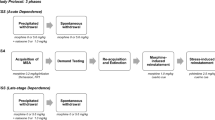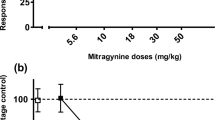Abstract
Rationale
Stimuli that are paired with opioid withdrawal can themselves produce effects similar to withdrawal that might promote relapse.
Objective
This study compared precipitated and conditioned withdrawal and tested whether withdrawal is modified by clonidine or morphine.
Methods
Morphine-treated rats (10 mg/kg/12 h) received naloxone (3.2 mg/kg) in a novel environment (conditioned stimuli [CS]). Other rats received naloxone in the absence of the CS. Body weight and observable signs were used to measure withdrawal.
Results
Naloxone produced weight loss and withdrawal signs in morphine-treated rats. Following pairings of the CS and naloxone, the CS alone had effects similar to naloxone; conditioned withdrawal was greater after three naloxone/CS pairings, as compared to one, and with longer morphine treatment. Antagonist-precipitated withdrawal was greater in rats that previously were physically dependent on morphine, as compared to withdrawal in rats that were never dependent; however, conditioned withdrawal did not differ between groups. When administered concurrently with naloxone, clonidine (0.1 mg/kg) attenuated some precipitated withdrawal signs, although conditioned withdrawal was largely unchanged. Administration of 10 mg/kg of morphine before the CS alone attenuated all conditioned withdrawal signs, whereas 0.1 mg/kg of clonidine before the CS alone reduced some directly observable signs and not weight loss.
Conclusions
Conditioned withdrawal occurs rapidly and is greater with longer periods of morphine treatment or more pairings of naloxone and the CS; however, a history of physical dependence does not increase conditioned withdrawal. Modification of conditioned withdrawal by drugs might be a useful approach for treating relapse.




Similar content being viewed by others
References
Amitai N, Liu J, Schulteis G (2006) Discrete cues paired with naloxone-precipitated withdrawal from acute morphine dependence elicit conditioned withdrawal responses. Behav Pharmacol 17:213–222
Azar MR, Jones BC, Schulteis G (2003) Conditioned place aversion is a highly sensitive index of acute opioid dependence and withdrawal. Psychopharmacology 170:42–50
DiStefano PS, Brown OM (1985) Biochemical correlates of morphine withdrawal. 2. Effects of clonidine. J Pharmacol Exp Ther 233:339–344
Galligan JJ, Burks TF (1983) Centrally mediated inhibition of small intestinal transit and motility by morphine in the rat. J Pharmacol Exp Ther 226:356–361
Goldberg SR, Schuster CR (1967) Conditioned suppression by a stimulus associated with nalorphine in morphine-dependent monkeys. J Exp Anal Behav 10:235–242
Goldberg SR, Woods JH, Schuster CR (1969) Morphine: conditioned increases in self-administration in rhesus monkeys. Science 166:1306–1307
Gossop M, Stewart D, Browne N, Marsden J (2002) Factors associated with abstinence, lapse or relapse to heroin use after residential treatment: protective effect of coping responses. Addiction 97:1259–1267
Holtzman SG (1985) Discriminative stimulus effects of morphine withdrawal in the dependent rat: suppression by opiate and nonopiate drugs. J Pharmacol Exp Ther 233:80–86
Irwin S, Seevers MH (1956) Altered response to drugs in the post addict (Macaca mulatta). J Pharmacol Exp Ther 116:31–32
Kalinichev M, Holtzman SG (2003) Changes in urination/defecation, auditory startle response, and startle-induced ultrasonic vocalizations in rats undergoing morphine withdrawal: similarities and difference between acute and chronic dependence. J Pharmacol Exp Ther 304:603–609
Kleber HD, Gold MS, Riordan CE (1980) The use of clonidine in detoxification from opiates. Bull Narcs 32:1–9
Koob GF, Stinus L, Le Moal M, Bloom FE (1989) Opponent process theory of motivation: neurobiological evidence from studies of opiate dependence. Neurosci Biobehav Rev 13:135–140
McLellan AT, Childress AR, Ehrman R, O’Brien CP, Pashko S (1986) Extinguishing conditioned responses during opiate dependence treatment: turning laboratory findings into clinical procedures. J Subst Abuse Treat 3:33–40
McNally GP, Akil H (2001) Effects of contextual or olfactory cues previously paired with morphine withdrawal on behavior and pain sensitivity in the rat. Psychopharmacology 156:381–387
O’Brien CP, Testa T, O’Brien TJ, Greenstein R (1976) Conditioning in human opiate addicts. Pav J Biol Sci 11:195–202
Parker L, Failor A, Weidman K (1973) Conditioned preferences in the rat with an unnatural need state: morphine withdrawal. J Comp Physiol Psychol 82:294–300
Rosen MI, McMahon TJ, Hameedi FA, Pearsall HR, Woods SW, Kreek MJ, Kosten TR (1996) Effect of clonidine pretreatment on naloxone-precipitated opiate withdrawal. J Pharmacol Exp Ther 276:1128–1135
Schnur P (1992) Conditioned morphine withdrawal in the hamster. Psychopharmacology 107:517–522
Schulteis G, Stinus L, Risbrough VB, Koob GF (1998) Clonidine blocks acquisition but not expression of conditioned opiate withdrawal in rats. Neuropsychopharmacology 19:406–419
Schulteis G, Morse AC, Liu J (2003) Repeated experience with naloxone facilitates acute morphine withdrawal: potential role for conditioning processes in acute opioid dependence. Pharmacol Biochem Behav 76:493–503
Sell LA, Cowen PJ, Robson PJ (1995) Ondanesetron and opiate craving, a novel pharmacological approach to addiction. Br J Psychiatry 166:511–514
Siegal S (1977) Learning and psychpharmacology. In: Jarvik ME (ed) Psychopharmacology in the practice of medicine. Appleton-Century-Crofts, New York, pp 61–70
Sinha R, Kimmerling A, Doebrick C, Kosten T (2007) Effects of lofexidine on stress-induced and cue-induced opioid craving and opioid abstinence rates: preliminary findings. Psychopharmacology 190:569–574
Solomon RL, Corbit JD (1974) An opponent-process theory of motivation. I. Temporal dynamics of affect. Psychol Rev 81:119–145
Sparber SB, Meyer DR (1978) Clonidine antagonizes naloxone-induced suppression of conditioned behavior and body weight loss in morphine-dependent rats. Pharmacol Biochem Behav 9:319–325
Stinus L, Caille S, Koob GF (2000) Opiate withdrawal-induced place aversion lasts up to 16 weeks. Psychopharmacology 149:115–120
Weinstein A, Wilson S, Bailey J, Myles J, Nutt D (1997) Imagery of craving in opiate addicts undergoing detoxification. Drug Alcohol Depend 48:25–31
Wikler A (1948) Recent progress in research on the neurophysiologic basis of morphine addiction. Am J Psychiat 105:329–338
Wikler A, Pescor FT (1967) Classical conditioning of a morphine abstinence phenomenon, reinforcement of opioid-drinking behavior and “relapse” in morphine-addicted rats. Psychopharmacologia 10:255–284
Author information
Authors and Affiliations
Corresponding author
Additional information
This work was supported by United States Public Health Service from the National Institute on Drug Abuse (DA 05018 and CPF is supported by a Senior Scientist Award [DA17918]). The content is solely the responsibility of the authors and does not necessarily represent the official views of the National Institute on Drug Abuse or the National Institutes of Health.
Rights and permissions
About this article
Cite this article
Becker, G.L., Gerak, L.R., Li, JX. et al. Precipitated and conditioned withdrawal in morphine-treated rats. Psychopharmacology 209, 85–94 (2010). https://doi.org/10.1007/s00213-009-1773-3
Received:
Accepted:
Published:
Issue Date:
DOI: https://doi.org/10.1007/s00213-009-1773-3




